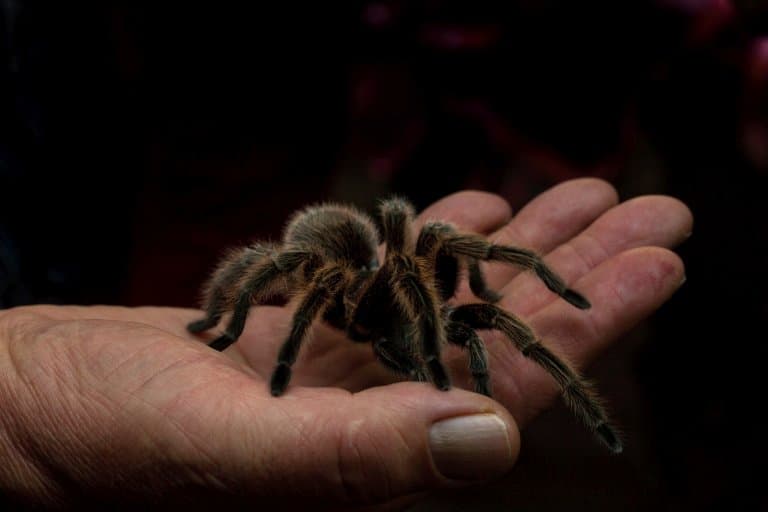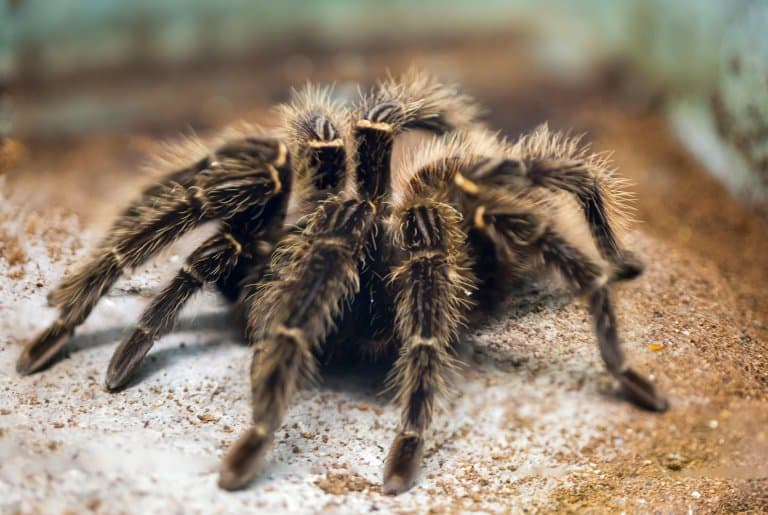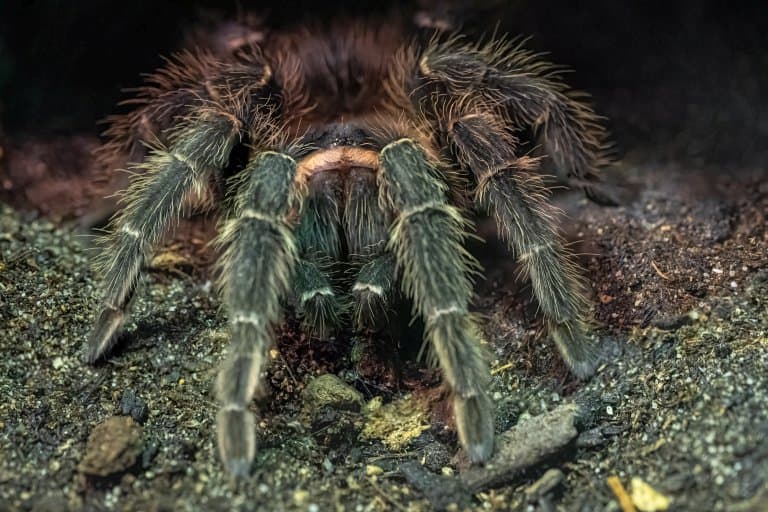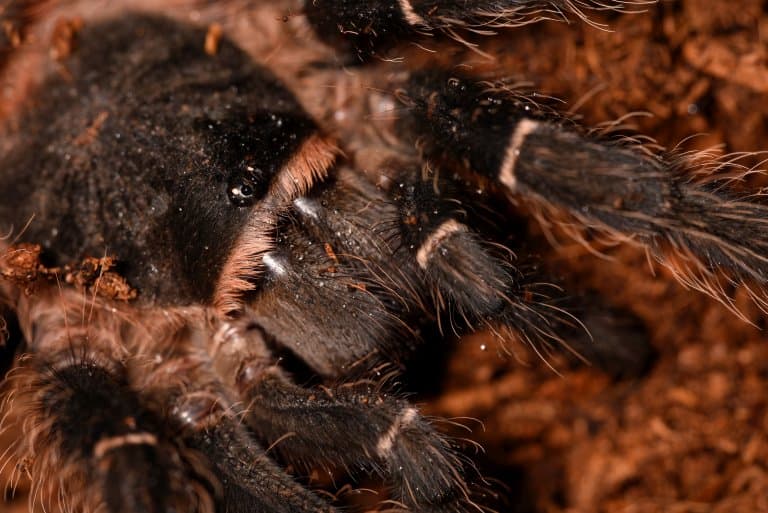Brazilian Salmon Pink Bird-eating Tarantula Profile
This is an animal that has gone for the title of “most classes represented in a name”, but it’s done so at a cost to accuracy.
About the only thing that’s not exaggerated is the word tarantula. And what a tarantula!
Ambushing its prey from inside rotting logs and leaf litter of the Amazon rainforest is one of the biggest spiders in the world: the Brazilian Salmon Pink Bird-eating Tarantula.

Brazilian Salmon Pink Bird-eating Tarantula Facts Overview
| Habitat: | Tropical rainforest |
| Location: | Eastern Brazil |
| Lifespan: | Up to 25 years in females |
| Size: | Up to 28cm (11 inches) legspan |
| Weight: | Over 100g (3.5oz) |
| Colour: | Black to brown, sometimes with a peach/pink fuzz |
| Diet: | Invertebrates, sometimes bats |
| Predators: | Birds, reptiles, small mammals, humans |
| Top Speed: | Fast (for a tarantula) |
| No. of Species: | 1 |
| Conservation Status: | Not Listed |
Salmon Pinks are bird-eaters in name only, as far as we know. Strangely, they prefer a different sort of flying vertebrate.
They’re in the top four largest species of tarantula, and like most new-world versions, they have an array of defences that includes irritating hairs, a sharp hiss, and a set of fangs that should give anyone second thoughts.
Females are larger than the males, but often less vibrant in color. Once mature, they have pink-red hairs along the legs, which is from where part of their long name is derived.
Their grandeur makes them popular exhibits among private collectors, and this might impact their success as a species in the wild, though the data is sorely lacking.
Interesting Brazilian Salmon Pink Bird-eating Spider Facts
1. They don’t eat birds really
Bird-eaters very rarely actually eat birds; the name is more symbolic of their size than their diet. While plenty big enough to consume a bird, they don’t have the ability to catch one, and may only be able to live up to their name if they stumble across a nest with some newborns in it.
Giant tarantulas like this feed almost exclusively on arthropods, probably because they’re easier to catch, but they are well-equipped to bring down small mammals too. And in multiple instances, this species has been known to catch and eat bats, though the method.
2. They don’t spin webs
Tarantulas live in burrows on the forest floor and will hide on the ground amongst leaf litter, or logs.
They are ambush predators, lying in wait, striking prey as it approaches, and injecting venom fast to subdue it. They do not weave webs to catch their prey, which large insects, amphibians and small reptiles would likely be able to escape from.
They do sometimes leave a strand of web outside their burrow which can alert them to prey!
3. Their leg span can reach over 27cm (11 inches)
They’re in the goliath family and very large spiders. The genus Therophosa contains all of the giants of the tarantula world, including the Goliath bird-eater.
Most tarantulas have hairy patellae, like the so-named Mexican redknee tarantula. But spiders like the Salmon Pink and other Therophosa are distinguished from other groups by a lack of these hairs.
Still, they’re far from bald. The fur on spiders is made of tiny columns of chitin, the cellulose-like carbohydrate that invertebrates commonly use for their exoskeleton.
This chitin is an incredibly versatile material, and Salmon Pink spiders even use it as an instrument.

4. They have stridulating hairs
When certain tarantulas get upset, they hiss. As if spiders weren’t already quite unsettling, this frightening alarm ensures that any limb that was still heading in its direction recoils rapidly.
In animals that don’t breathe through their mouths, hissing is commonly achieved by scraping body parts onto other body parts, and in most cases, this is some special hardened comb-like organ that’s attached to the legs or wing case, like in crickets.
In these spiders, the hiss comes from special barbed hairs on the legs. These are stiff combs that essentially act like a scraping mechanism and give the animal an audible dimension to its defences. 1
5. They also have urticating hairs
But if hissing still doesn’t put you off, there’s another line of protection available to the spider, and this comes from a different sort of hair.
If you were to look at the leaf of a stinging nettle under the microscope, you’d see hollow hypodermic needles made of glass. These tiny hairs are brittle and filled with a toxin that causes the familiar sting you get when brushing past the leaves.
Spiders have a very similar defence mechanism and in the Salmon Pink, these hairs are tiny, feathery barbs, detachable from the abdomen if the animal feels threatened, and designed to cause severe irritation.
These urticating hairs are rubbed off from the cuticle of the spider by its hind legs and float about into your airways or get stuck in your skin like the microscopic fibres of cactuses.
But if hissing and irritating dust still isn’t enough for you to get the message, they can still do what spiders are known best for. 2

6. They have a big bite
All spiders have fangs, and they’re all venomous to varying degrees. This is a huge spider, and consequently, it has huge fangs.
These mouthparts can grow to more than 6cm (2.5 inches) long, and the Salmon Pink is not afraid to use them. They’re said to be a semi-aggressive species, and if pushed, will gladly sink these enormous needles into the flesh of a threat.
They’re also fast for a tarantula and have plenty of energy with which to attack or escape. 3
7. But they’re not dangerous
Despite all this, Salmon Pink Bird-Eaters aren’t a legitimate threat to anyone in good health.
The enormous fangs will certainly hurt if they enter your skin, and the venom injection that comes along with it won’t be a pleasant experience, either.
But like all tarantulas, these enormous spiders have relatively weak venom that’s not designed to defend against or harm large mammals. Setting aside the risk of an allergic reaction, the only real danger from a tarantula bite of any kind is a secondary infection from a large piercing wound.
And while the urticating hairs can be annoying, they’re not going to kill you either (though in rare instances they may cause blindness!) 4

8. Males are short-lived
There’s a huge difference in longevity between males and females of this species. Males are identifiable by their slender bodies and by the set of hooks present on their legs.
These hooks serve the important purpose of blocking the fangs of the much larger female during mating. This dangerous dance can and does end in the male being eaten in some cases, but even if he survives the act, his days are numbered.
Compared with the impressive 25 years a female L. parahyba can reach, males typically live no longer than 5 years. 5
9. Could they be threatened by the pet trade?
Tarantulas are common subjects for collectors, both as live and dead specimens, and of course, the largest of them are of particular interest.
A spider with legs as wide as a diner plate makes for a popular collector’s item and this might lead to unsustainable harvests from their habitats.
This species isn’t an easy one to breed in captivity, so there are concerns about where they’re sourced. While there are laws restricting the exotic pet trade, they’re not well enforced, and in the case of spiders, research, conservation and funding are all lacking compared with less-scary invertebrates like insects.
This species isn’t even listed on the IUCN, and surveys don’t appear to be planned any time soon, so sadly we know very little about the situation of this species in the wild. 6
Brazilian Salmon Pink Bird-eating Spider Fact-File Summary
Scientific Classification
| Kingdom: | Animalia |
| Phylum: | Arthropoda |
| Class: | Arachnida |
| Order: | Araneae |
| Family: | Theraphosidae |
| Genus: | Lasiodora |
| Species: | Lasiodora Parahybana |
Fact Sources & References
- John Mcdonnell (2016), “Theraphosa, Goliath Birdeater stridulating sound when threatened”, YouTube.
- Andrew (2017), “TARANTULA SPIDER FACTS”, PS Micrographs.
- “Salmon Pink Birdeater”, Chessington Garden Centre.
- “Salmon Pink Birdeater Tarantula (Lasiodora parahybana) Care Sheet”, The Tarantula Collective.
- The Tarantula Cave (2021), “Brazilian Salmon Pink Birdeater (Lasiodora parahybana) Pairing / Breeding”, YouTube.
- “Cornell Chronicle”, Cornel University.
